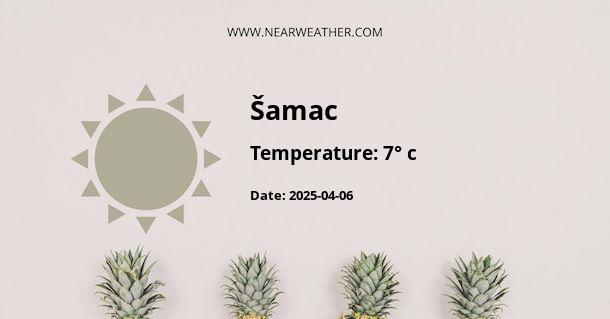The Climate and Weather of Bosanski Samac, Bosnia and Herzegovina
Bosanski Samac, a town situated in the northern part of Bosnia and Herzegovina, experiences a continental climate influenced significantly by its position in the Balkan Peninsula. Understanding this location's climate and weather patterns year-round involves examining various meteorological elements, including temperature, precipitation, and seasonal changes.
Overview of Bosanski Samac's Climate
According to the Köppen climate classification, Bosanski Samac falls under the category of a Humid Continental climate, characterized by large seasonal temperature differences, with warm to hot (and often humid) summers and cold (sometimes severely cold) winters.
Temperature Variations Throughout the Year
In Bosanski Samac, temperature fluctuations reflect a classical inland climate. The winters are typically cold, and summers are warm which sometimes lead to uncomfortably high temperatures. Detailed statistics gathered from meteorological stations present the following averages:
| Month | Average High (°C) | Average Low (°C) |
|---|---|---|
| January | 3 | -3 |
| February | 6 | -2 |
| March | 12 | 2 |
| April | 17 | 7 |
| May | 22 | 12 |
| June | 25 | 15 |
| July | 27 | 17 |
| August | 27 | 16 |
| September | 23 | 13 |
| October | 17 | 8 |
| November | 10 | 3 |
| December | 5 | -1 |
These figures clearly illustrate the considerable fluctuation in temperature, necessitating adaptive living conditions and infrastructure for Bosanski Samac's residents throughout the seasons.
Precipitation Patterns in Bosanski Samac
As with most continental climates, Bosanski Samac witnesses a substantial amount of precipitation spread evenly over the year. Snow is common in the winter months, often persisting and resulting in a picturesque yet sometimes challenging environment for transportation and daily activities.
- Spring: The period from March to May sees increasing levels of precipitation, with concomitant temperature rises, leading to the melting of any snow accumulated over winter.
- Summer: June through August marks the warmest period of the year. During this time, convective rainfall is common, potentially causing sudden, intense storms that result in higher rainfall totals in short periods.
- Autumn: From September to November, precipitation decreases gradually, and temperatures cool, creating a comfortable climate before the winter sets in.
- Winter: December through February is marked by snow and sleet, with the potential for significant snowfall contributing to the overall precipitation totals.
"Bosanski Samac is a prime example of a continental climate, where the seasonal contrast is not only prominent in temperature cycles but also evident in varied precipitation patterns, contributing to the rich fabric of this region's meteorological narrative." - Regional Weather Expert, Balkans Climate Research Institute
Seasonal Weather Conditions
Spring
Spring in Bosanski Samac brings a gradual increase in temperatures and a noticeable shift toward greener landscapes as nature awakens from its winter slumber. This can be an unpredictable season weather-wise, with occasional frosts extending into early spring or sudden warm spells arriving as early as March.
Summer
The summer months herald the arrival of the warmest and most pleasant weather, with long, sunny days. However, these are also the times when Bosanski Samac may experience bouts of extreme heat, especially in July and August, which can have implications for public health and energy consumption.
Autumn
Autumn sees a reversal of spring's warming trend with a smooth but noticeable drop in temperatures. This is often considered one of the most comfortable periods weather-wise, as the extreme conditions of summer and winter remain distant.
Winter
Winters are typically harsh with below-freezing temperatures, particularly in January, the coldest month. Snowfall can be heavy at times, and the region is adept at managing these seasonal challenges through well-established snow-clearance and road-safety protocols.
Adaptation to the Climate
The people of Bosanski Samac have adapted to their climate over generations. Buildings are constructed to provide insulation from the cold winter temperatures, and city infrastructure is designed to combat the challenges posed by snow and ice. Moreover, a strong emphasis is placed on weather forecasting and emergency planning, particularly regarding agricultural and energy sectors that are sensitive to weather extremes.
Climate Change Considerations
In recent years, Bosanski Samac, like much of the world, has felt the impacts of climate change. An increasing frequency of extreme weather events, such as intense heatwaves in the summer and severe snowstorms in the winter, has been observed. These trends require continuous monitoring and adaptation strategies to ensure the region is prepared to withstand the evolving climate conditions.
Final Thoughts
The climate and weather patterns of Bosanski Samac provide an excellent case study of the ways in which a community adapts to and lives with the seasons' rhythm in a continental climate. From the adaptations made by residents to the challenges presented by climate change, Bosanski Samac's climate and weather represent a dynamic and integral part of its regional identity.
A - Šamac's Latitude is 45.059170 & Longitude is 18.466940.
A - Weather in Šamac is 7° today.
A - Climate Conditions in Šamac shows moderate rain today.
A - Humidity in Šamac is 77% today.
A - Wind speed in Šamac is 18.79 km/h, flowing at 309° wind direction. today.
